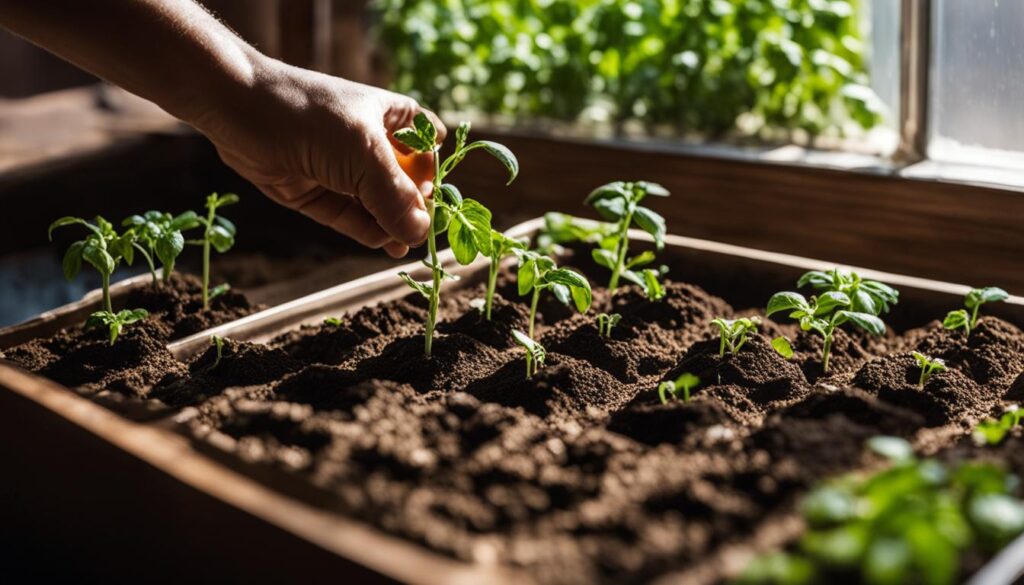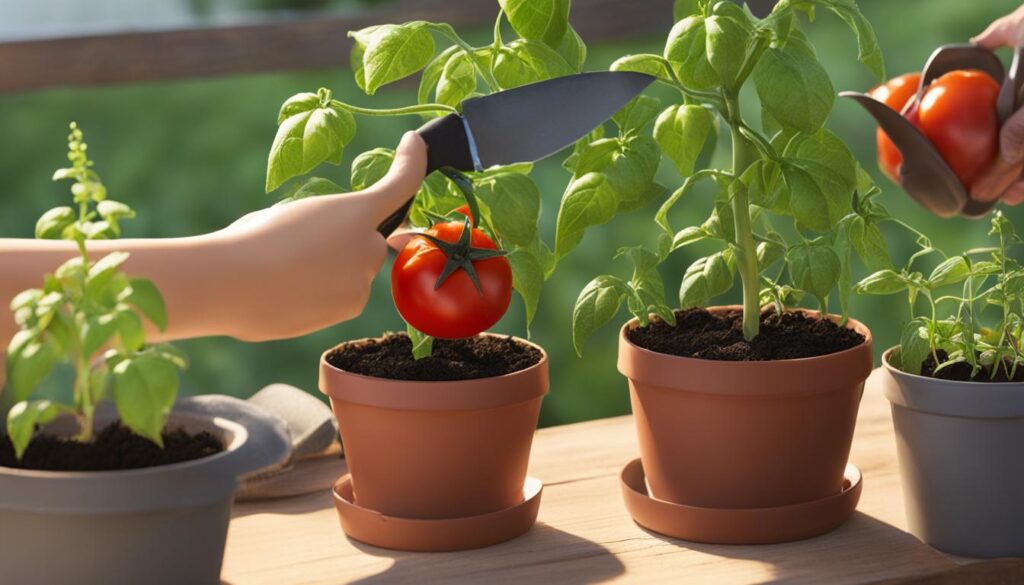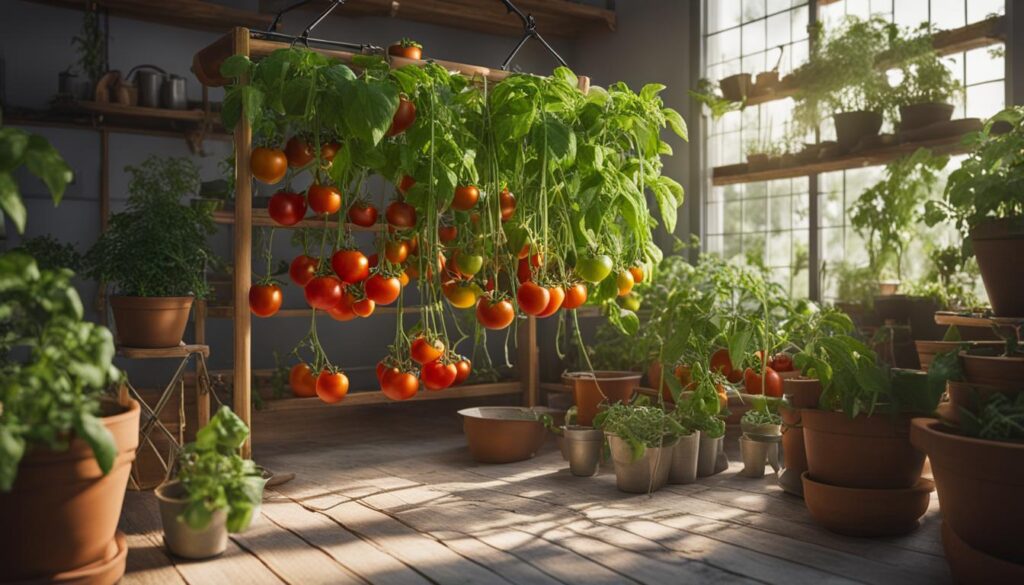Are you looking to enjoy the taste of fresh tomatoes year-round? Starting an indoor tomato garden is a great way to have a bountiful supply of homegrown tomatoes, even if you don’t have a large outdoor space. Whether you’re a seasoned gardener or a beginner, this guide will walk you through the process of growing tomatoes indoors.
Indoor tomato gardening allows you to take control of your growing environment, ensuring the perfect conditions for your plants to thrive. You can grow tomatoes indoors regardless of the season, meaning you’ll never have to rely solely on store-bought tomatoes again.
Ready to get started? Here are some essential tips for starting an indoor tomato garden:
Post Summary:
- Starting an indoor tomato garden allows you to enjoy fresh tomatoes year-round.
- Growing tomatoes indoors provides you with control over environmental conditions and protection from pests and diseases.
- Choose compact and bushy tomato varieties labeled as “patio” or “bush” for successful indoor gardening.
- Start tomato seeds indoors about 6-8 weeks before the last expected spring frost.
- Transplant your indoor tomato seedlings into larger containers using good quality potting mix.
With these tips in mind, you’ll be well on your way to growing delicious tomatoes indoors. Let’s dive deeper into each step of the process and explore the benefits, varieties, care, and harvesting of indoor tomato plants. Get ready to enjoy the fruits of your labor, right from the comfort of your own home!
Benefits of Growing Tomatoes Indoors
Growing tomatoes indoors offers numerous benefits that make it a popular choice among gardeners. Whether you have limited outdoor space or simply want fresh tomatoes year-round, indoor tomato gardening can be a rewarding and enjoyable experience. Here are some advantages of growing tomatoes indoors:
Extended Growing Seasons
One of the major benefits of indoor tomato gardening is the ability to extend the growing season. By growing tomatoes indoors, you can start planting earlier in the year and continue harvesting tomatoes well into the fall and winter months. This means you can enjoy fresh, homegrown tomatoes throughout the year, regardless of the outdoor climate.
Control Over Environmental Conditions
When you grow tomatoes indoors, you have complete control over the growing environment. You can adjust factors like temperature, humidity, light exposure, and air circulation to create optimal conditions for tomato growth. This control allows you to provide consistent and ideal conditions for your plants, resulting in healthier and more productive tomato crops.
Protection from Pests and Diseases
Indoor tomato gardening helps protect your plants from pests and diseases that can affect outdoor gardens. By keeping your tomatoes indoors, you can prevent common tomato pests like aphids, caterpillars, and tomato hornworms from damaging your plants. Additionally, you can avoid diseases spread by soilborne pathogens, such as fusarium wilt and bacterial spot, which can be a challenge to control in outdoor gardens.
Table: Comparison of Indoor and Outdoor Tomato Gardening
| Factors | Indoor Tomato Gardening | Outdoor Tomato Gardening |
|---|---|---|
| Growing Season | Extended growing season, year-round if desired | Seasonal, typically spring to fall |
| Control Over Environment | You can control temperature, humidity, light, and air circulation | Reliant on natural conditions, less control over environmental factors |
| Pest and Disease Management | Reduced risk of pests and diseases indoors | Increased risk of pests and diseases in outdoor environments |
| Space Requirements | Can be grown in small spaces, like apartments or balconies | Requires larger outdoor garden space |
| Accessibility | Easily accessible for care and maintenance | May require more physical effort for maintenance and harvesting |
As you can see, growing tomatoes indoors offers several advantages over outdoor gardening. It allows for year-round cultivation, provides better control over the growing conditions, and minimizes the risk of pests and diseases. Consider indoor tomato gardening for a convenient, productive, and enjoyable gardening experience.
Choosing the Right Tomato Varieties for Indoor Gardening
When it comes to indoor tomato gardening, choosing the right tomato varieties is key to success. Compact and bushy varieties labeled as “patio” or “bush” are ideal for growing tomatoes indoors. These varieties are specially bred to thrive in limited space and have a shorter growth habit, making them well-suited for containers.
For a bountiful harvest, consider selecting cherry, grape, Roma, and small slicer types of tomatoes. Cherry tomatoes are perfect for snacking and salads, while Roma tomatoes are great for making sauces. Grape tomatoes are known for their delicious sweet flavor, and small slicer varieties are ideal for slicing in sandwiches or adding to dishes.
One interesting option for indoor tomato gardening is the Kitchen Minis. These tabletop-sized plants are specially bred for small spaces and are easy to grow indoors. With their compact size, they make a perfect addition to your kitchen countertop or windowsill.
To help you choose the right tomato varieties, here’s a table summarizing the best options for indoor gardening:
| Tomato Variety | Characteristics |
|---|---|
| Cherry Tomatoes | Small, sweet, and perfect for snacking |
| Grape Tomatoes | Deliciously sweet and ideal for adding to salads |
| Roma Tomatoes | Meaty texture, perfect for making sauces |
| Small Slicer Varieties | Perfect for slicing in sandwiches and adding to dishes |
| Kitchen Minis | Compact, tabletop-sized plants for small spaces |
With these tomato varieties, you’ll have a wide range of options for indoor gardening and enjoy the delicious taste of homegrown tomatoes right in your own home.
Starting Tomato Seeds Indoors
Sowing tomato seeds indoors is a crucial step in establishing a successful indoor tomato garden. By starting your seeds indoors, you can give them a head start on the growing season and ensure strong, healthy plants. Here’s how to sow tomato seeds indoors:
Gather Your Materials
Before starting, gather all the necessary materials. You will need:
- Seed-starting mix
- Containers or trays
- Tomato seeds
- A spray bottle for watering
- Labels or markers to identify the varieties
Prepare the Containers
Fill the containers or trays with seed-starting mix, leaving about half an inch of space at the top. Moisten the mix with water, ensuring it is evenly damp but not overly wet.
Plant the Seeds
Make shallow furrows in the moist seed-starting mix, about a quarter inch deep. Place the tomato seeds in the furrows, spacing them according to the seed packet instructions. Cover the seeds lightly with soil and gently firm the mix over them.
Provide Optimal Conditions
Place the containers in a warm location with temperatures between 70-80°F (21-27°C). Tomato seeds germinate best in warm soil. To maintain the moisture levels, mist the soil with water using a spray bottle when necessary.
Monitor and Care for the Seedlings
Keep a close eye on the containers and monitor the soil moisture regularly. As the seedlings emerge, provide them with ample light by placing them under grow lights or near a sunny window. Adjust the lights to keep them within a few inches of the seedlings to prevent them from getting leggy.
Transplant the seedlings into larger containers once they develop their true leaves. This usually happens when they are 2-3 inches tall. Be careful when handling the seedlings to avoid damaging the delicate root systems.
By following these steps, you can successfully start tomato seeds indoors and set yourself up for a productive and rewarding indoor tomato garden.
Transplanting Indoor Tomato Seedlings
Once your indoor tomato seedlings have developed true leaves, it’s time to transplant them into larger individual containers. This step is essential to ensure optimal growth and yield in your tomato plants. Transplanting allows the seedlings to establish deeper root systems and provides them with more space to grow.
To transplant the seedlings, gently remove them from their original containers, being careful not to damage the roots. Fill the new containers with a good quality potting mix, leaving enough space for the roots. Make a small hole in the center of the new container and carefully place the seedling in it, ensuring that the stem is buried up to the first set of leaves. This will encourage the development of new roots along the buried stem.
After transplanting, water the seedlings thoroughly to ensure good soil contact and help them recover from the transplant shock. Place the containers in a warm and well-lit area, ideally near a sunny window or under grow lights. Provide them with regular waterings, keeping the soil consistently moist but not waterlogged.
Before moving your indoor tomato plants outdoors, it’s important to gradually acclimate them to outdoor conditions. This process, known as hardening off, helps the plants adjust to the differences in temperature, light intensity, and wind. Start by placing the seedlings outside in a sheltered spot for a few hours a day, gradually increasing the time and exposure over the course of a week. This will help prevent transplant shock and give your plants the best chance of thriving in their new environment.
| Transplanting Indoor Tomato Seedlings | Tips |
|---|---|
| Transplant seedlings into larger individual containers to provide more space. | • Choose containers with drainage holes to prevent waterlogging. • Use a good quality potting mix for optimal growth. • Bury the stem up to the first set of leaves to encourage root development. • Water thoroughly after transplanting to ensure good soil contact. • Place the containers in a warm and well-lit area. |
| Gradually acclimate the seedlings to outdoor conditions before planting in the garden. | • Start by placing the seedlings outside for a few hours a day. • Increase exposure gradually over the course of a week. • Choose a sheltered spot to protect the seedlings from harsh weather conditions. • Monitor the seedlings closely during the hardening off process. |
Caring for Indoor Tomato Plants
Proper care is essential for the success of your indoor tomato plants. Follow these guidelines to ensure healthy growth and bountiful harvests.
Lighting and Temperature
Indoor tomato plants require adequate light to thrive. Place them near a sunny window or use grow lights to provide the necessary amount of light. Aim for 10-12 hours of light per day to promote strong growth.
It’s also important to maintain the right temperature for your tomato plants. Keep the temperature between 70-80°F during the day and slightly cooler at night. Avoid exposing the plants to cold drafts, as they can stunt growth and affect fruit development.
Watering and Fertilizing
Watering is a critical aspect of caring for indoor tomato plants. Check the soil moisture daily and water them regularly to keep the soil evenly moist. Be careful not to overwater, as it can lead to root rot.
Fertilizing is necessary to provide essential nutrients to your plants. You can use slow-release fertilizer pellets or water-soluble fertilizer. Follow the package instructions for the appropriate dosage and frequency of application.
Pollination and Rotation
Indoor tomato plants may require assistance with pollination. Gently shake the plants or use a small fan to simulate the wind and promote pollination.
To prevent your tomatoes from leaning towards the light source, rotate the plants every few days. This will ensure even growth and prevent the plants from becoming lopsided.
By providing the right conditions and giving proper care to your indoor tomato plants, you can enjoy a continuous supply of fresh tomatoes right at home.
Staking and Supporting Indoor Tomato Plants
When growing tomatoes indoors, it’s important to provide proper support for the plants, as indoor tomato plants tend to have weaker stems compared to their outdoor counterparts. Staking and supporting your indoor tomato plants will help keep them upright as they grow, preventing the stems from bending or breaking under the weight of the fruit.
One effective method of support is using bamboo stakes. These can be inserted into the soil alongside the plant, providing a sturdy structure for the tomato vine to lean on. Make sure to choose stakes that are tall enough to accommodate the height of the plants as they grow.
Another key aspect of supporting indoor tomato plants is using ties to secure the plants to the stakes. Soft plant ties or garden twine can be gently wrapped around the main stem and attached to the stake, providing additional stability. Avoid tying the stems too tightly, as this can restrict growth and potentially damage the plant.
By staking and supporting your indoor tomato plants, you will not only help them grow upright and healthy, but also ensure that the fruit is easily accessible and protected from damage. Remember to regularly check the plants and adjust the ties as necessary, as the tomato vines can rapidly grow and require constant support.
| Supporting Indoor Tomato Plants | Benefits |
|---|---|
| Staking with bamboo stakes | Provides a sturdy structure for the tomato vine to lean on |
| Using ties | Secures the plants to the stakes, providing additional stability |
| Preventing stem damage | Ensures that the fruit is easily accessible and protected from damage |
Harvesting Indoor Tomatoes
Once your indoor tomato plants have matured and produced fruit, it’s time to harvest your delicious homegrown tomatoes. Knowing when to pick the tomatoes is crucial to ensure the best flavor and texture. Harvesting times can vary depending on the tomato variety and your personal preferences.
Heirloom tomatoes, known for their rich and complex flavors, should be picked when fully ripe. Look for vibrant colors, firm but slightly soft texture, and a strong tomato aroma. For the best flavor experience, allow the tomatoes to fully ripen on the vine before picking.
Slicers, on the other hand, can be harvested at any stage of ripeness. If you prefer firmer and slightly tart tomatoes, you can pick them when they have reached their desired size. For a sweeter and juicier taste, allow the slicers to fully ripen on the vine before harvesting.
| Tomato Variety | Harvesting Time |
|---|---|
| Heirloom | Pick when fully ripe |
| Slicers | Harvest at desired ripeness |
| Cherry tomatoes | Pick when fully ripe, slightly soft |
| Beefsteak | Pick when fully ripe, firm but slightly soft |
When harvesting, gently twist or cut the tomato stem near the fruit to avoid damaging the plant. Handle the tomatoes with care to prevent bruising. If you have an abundance of tomatoes, consider freezing sauce tomatoes for later use in homemade sauces, soups, or stews. Enjoy the sweet and tangy flavors of cherry tomatoes in salads, pasta dishes, or as a quick snack. Savor the juicy and meaty goodness of beefsteak tomatoes in sandwiches, burgers, or fresh tomato salads.
With proper harvesting techniques, you can fully enjoy the fruits of your indoor tomato garden. Experiment with different varieties and ripeness levels to find the perfect flavor combination for your culinary creations.
Transplanting Indoor Tomato Plants Outdoors
Moving your indoor tomato plants outdoors is an exciting step towards seeing your hard work flourish in the garden. Choose a cool or overcast day to transplant your tomatoes to minimize stress on the plants. Before you begin, ensure that the threat of frost has passed and the soil has warmed up sufficiently.
To transplant your indoor tomato plants, dig a hole in your garden bed that is slightly larger than the size of the root ball. Gently remove the tomato plant from its container, being careful not to damage the roots. Place the plant in the hole, making sure it is positioned at the same depth as it was in its pot. The buried stem will develop new roots, providing the plant with a stronger foundation.
After planting, provide support for your tomato plants to prevent them from falling over as they grow. Use stakes made of bamboo or other sturdy materials, securing them in the ground near the base of the plant. Use soft ties, such as garden twine, to loosely fasten the main stem of the plant to the stake. This will help the plant stay upright and ensure proper air circulation.
Transplanting Indoor Tomato Plants Outdoors
| Steps | Instructions |
|---|---|
| 1 | Choose a cool or overcast day to transplant your indoor tomatoes. |
| 2 | Prepare the garden bed by digging a hole slightly larger than the root ball size. |
| 3 | Gently remove the tomato plant from its container, being careful not to damage the roots. |
| 4 | Place the plant in the hole, ensuring it is at the same depth as it was in its pot. |
| 5 | Provide support to the plant using stakes and soft ties to prevent it from falling over. |
Proper Care After Transplanting
After transplanting, continue to care for your outdoor tomato plants to ensure their healthy growth and fruit production. Regularly water the plants, keeping the soil evenly moist but not waterlogged. Monitor the plants for signs of pests or diseases and take appropriate action if necessary. Properly fertilize the plants following the instructions on the packaging of a slow-release fertilizer or water-soluble fertilizer.
By following these transplanting guidelines and providing diligent care, you can successfully transition your indoor tomato plants to the outdoor garden, enabling them to thrive and produce a bountiful harvest.
Tips for Successful Indoor Tomato Gardening
Successfully growing tomatoes indoors requires attention to several key factors. Follow these tips to ensure healthy growth and a bountiful harvest of delicious tomatoes.
- Provide Adequate Lighting: Tomatoes need at least 12-14 hours of direct sunlight or artificial light each day. Position your plants near a sunny window or use grow lights to supplement natural light.
- Maintain Optimal Temperature: Keep the temperature consistently between 70-80°F during the day and slightly cooler at night. Avoid exposing your plants to cold drafts, as this can stunt their growth.
- Water Regularly: Check the moisture level of the soil daily and water your tomato plants thoroughly whenever the top inch of soil feels dry. Ensure that your pots have good drainage to prevent waterlogging.
- Fertilize Appropriately: Use a slow-release granular fertilizer or water-soluble fertilizer formulated for tomatoes. Follow the package instructions to determine the proper dosage and application frequency.
- Promote Pollination: Indoor tomato plants may require assistance with pollination since there are no natural pollinators indoors. Gently shake the plants or use a small fan to simulate wind and help the pollen transfer between flowers.
- Provide Support: As indoor tomato plants tend to have weaker stems, it’s essential to provide them with proper support. Use stakes or tomato cages to keep the plants upright as they grow.
- Monitor for Pests and Diseases: Indoor tomato plants are generally less prone to pests and diseases compared to outdoor plants. However, it’s still important to regularly inspect your plants for signs of aphids, whiteflies, or fungal infections. Treat any issues promptly to prevent further damage.
- Rotate Your Plants: To ensure even growth and prevent leaning, rotate your tomato plants every few weeks. This will help each side of the plant receive equal exposure to light.
Following these indoor tomato gardening tips will help you create an optimal environment for your plants, leading to healthy growth and a successful harvest. Enjoy the rewards of homegrown tomatoes all year round!
Tips from Expert Gardener:
“When growing tomatoes indoors, don’t be afraid to experiment with different varieties and techniques. Each indoor garden is unique, and you may discover surprising success with certain tomato types or care practices. Remember to have fun and enjoy the process!”
Conclusion
So, there you have it – a complete guide to starting and maintaining your indoor tomato garden. By following these steps, you can enjoy the delicious taste of homegrown tomatoes all year round.
To summarize the indoor tomato gardening process, begin by choosing the right tomato varieties suited for indoor gardening. Compact and bushy varieties labeled as “patio” or “bush” are ideal. Next, start your tomato seeds indoors about 6-8 weeks before the last expected spring frost. Once the seedlings have true leaves, transplant them into larger containers using good quality potting mix.
Provide proper care for your indoor tomato plants, including adequate lighting, temperature control, regular watering, and appropriate fertilization. Support the plants by staking them using bamboo stakes and ties for added stability. When the tomatoes are ripe, harvest them accordingly – full ripeness for heirloom varieties, and at any stage for slicers.
If you decide to move your indoor tomatoes to the garden, choose a cool day for transplanting and plant them deeper to encourage strong root growth. Finally, remember to provide ongoing care and attention to ensure healthy growth and fruitful production.
With dedication and the right techniques, you’ll be rewarded with a thriving indoor tomato garden filled with delicious, homegrown tomatoes. So, wrap up your indoor tomato gardening journey, put your green thumb to work, and enjoy the satisfaction of growing your own tomatoes!
Can the Indoor Tomato Garden Guide Apply to Growing Tomatoes in 5 Gallon Buckets?
Yes, the indoor tomato garden guide can apply to growing tomatoes in 5 gallon buckets. When watering tomatoes in buckets, it’s important to ensure they have proper drainage and use a high-quality potting mix. Additionally, consistent watering is key to keeping the plants healthy and productive.
FAQ
Q: What are the benefits of growing tomatoes indoors?
A: Growing tomatoes indoors provides extended growing seasons, control over environmental conditions, and protection from pests and diseases.
Q: What tomato varieties are best for indoor gardening?
A: Select compact and bushy varieties labeled as “patio” or “bush,” such as cherry, grape, Roma, small slicers, and Kitchen Minis.
Q: How do I start tomato seeds indoors?
A: Start tomato seeds indoors about 6-8 weeks before the last expected spring frost. Make shallow furrows in moist seed-starting mix, sow seeds, cover lightly with soil, and provide a warm and well-lit environment.
Q: How do I transplant indoor tomato seedlings?
A: Once the seedlings have true leaves, transplant them into larger individual containers using good quality potting mix. Buried stems will develop new roots. Harden off the plants gradually by acclimating them to outdoor conditions before planting in the garden.
Q: How do I care for indoor tomato plants?
A: Provide adequate light using grow lights or a sunny window, keep the temperature between 70-80°F, shield plants from cold drafts, water regularly, fertilize with slow-release pellets or water-soluble fertilizer, pollinate the flowers, and rotate the plants to prevent leaning.
Q: How do I support indoor tomato plants?
A: Use bamboo stakes and ties to keep the plants upright as they grow.
Q: When should I harvest indoor tomatoes?
A: Harvesting times vary depending on the tomato variety. Heirloom varieties should be picked at full ripeness, while slicers can be harvested at any stage. Sauce tomatoes can be frozen for later use.
Q: How do I transplant indoor tomato plants outdoors?
A: Choose a cool or overcast day to transplant your indoor tomatoes into the garden. Plant them deeper than they were in their pots to encourage strong root growth. Provide support and regular care to ensure healthy growth and fruit production.
Q: What are some tips for successful indoor tomato gardening?
A: Ensure proper lighting, temperature, and watering for healthy growth. Pay attention to pollination, stem strength, and support. Choose the right tomato varieties for indoor gardening and follow proper transplanting techniques. Regular care and attention will lead to a successful indoor tomato garden.
Q: How do I start an indoor tomato garden?
A: Starting an indoor tomato garden allows you to enjoy homegrown tomatoes throughout the year. Follow the steps outlined in this guide, and with proper care and attention, you can grow tasty tomatoes indoors. Happy gardening!















